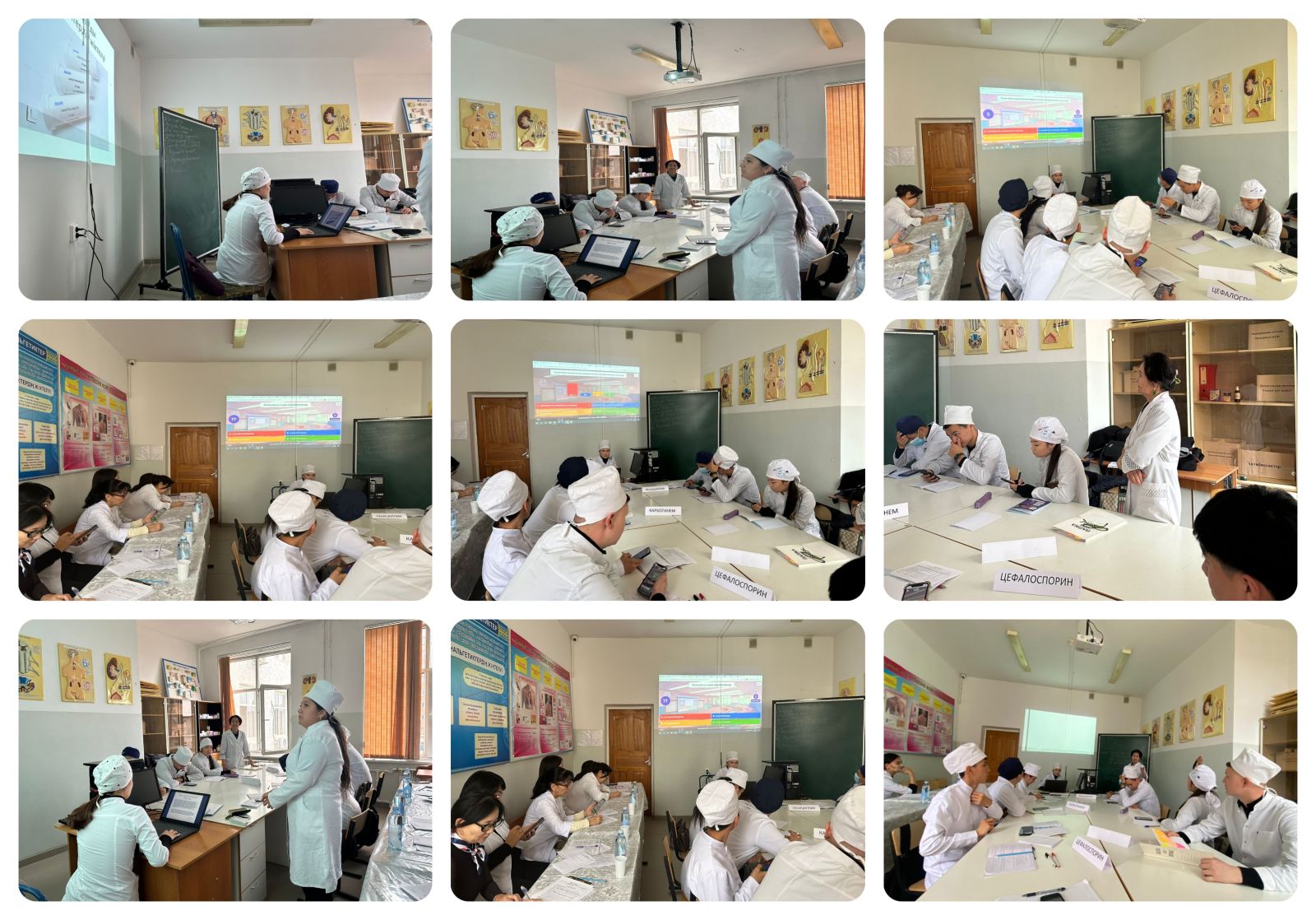PRACTICAL LESSON USING ACTIVE LEARNING METHODS

At the Department of “pharmacology, pharmacotherapy, and clinical pharmacology” on November 22, 2023, from 12.00 to 14.50, an open practical lesson was held in the discipline “Pharmacology” using active interactive teaching methods on the topic “Antibiotics. β-lactam antibiotics” for 3rd-year students В-СТҚБ-01-21 educational program 6B10103 "Dentistry" Senior teacher Duisembaeva B.T conducted the lesson.
The teacher began the lesson by setting the goals of the practical lesson: to formulate solid knowledge about antibiotics, learn to give competent recommendations on the use of effective, safe, and affordable drugs for etiotropic therapy, taking into account their pharmacokinetics, pharmacodynamics, interactions with other drugs, individual sensitivity, concomitant diseases, functional state of the body; learn to write prescriptions for antibiotics in the appropriate form, using reference books; learn to use sources of clinical and pharmacological information - reference books, electronic databases, Internet resources, intensify learning processes by creating effective cognitive activity of students, instill elements of a culture of communication in the course of joint activities.
The teacher presented a clear timing of the stages of the lesson. The updating of basic knowledge was carried out as a presentation of the topic using an electronic presentation (PowerPoint) of students, where they gave their answers to the questions under consideration on the topic of antibiotics. β-lactam antibiotics.” Students showed their ability to generalize and draw conclusions, the ability to analyze the properties of groups of drugs and individual representatives, the mechanisms of action of each group of drugs, pharmacokinetics, and pharmacodynamics of antibiotics, and give recommendations to the patient on the use of drugs in various dosage forms. The presentations visualized the theoretical material in the practical lesson, which contributed to better perception.
For the most effective consolidation of knowledge and skills on the topic: “antibiotics, β-lactam antibiotics”, and the formation of general and professional competencies of students, the teacher involved them in discussing educational material using active teaching methods - Heuristic conversation
Heuristic conversation. The method received its name from the teaching method of “heuristics”, which dates back to Socrates (Greek – I find, I seek, I discover). This method, through skillfully formulated leading questions and examples, encouraged students to come to the correct answer on their own. By its psychological nature, a heuristic conversation, in modern understanding, is collective thinking or conversation as a search for an answer to a problem. In pedagogy, this method is considered to be the method of problem-based learning (problem-search conversation). It should be borne in mind that this method assumes that students have a certain stock of knowledge, ideas, and concepts.
When preparing for a conversation, the teacher must: a) clearly define the goal; b) draw up a summary plan; c) choose visual aids; d) formulate main and auxiliary questions. It is important to formulate and ask questions correctly:
– they must be logically connected;
– they must correspond to the level of development of students;
– they should not suggest the answer.
The heuristic method is a teaching method that promotes active and effective interaction of students with each other and with the teacher. Team learning makes students the main protagonist, maximally involved in the educational process from a passive object and bearing personal responsibility for improving academic performance. This method allows the teacher to teach students practical thinking along with theoretical training. The great appeal of the method lies in the efficient use of available resources and the active participation of students, which is usually achieved only by dividing them into small groups.
Thus, for the next stages of the lesson, the group was divided into two subgroups. The teacher proposed the following forms and game methods for working with students in small groups:
1. Work with the table - tables are given on the mechanism of action of drugs from the group of penicillin, cephalosporin, monobactam, carbapenems, classification of drugs against pathogens (depending on the type of exposure to pathogens), characteristics of individual representatives of drug groups to fill the missing elements by students,
2. “Kahoot” testing using the platform
3. “Cell Game” - in the cells, there were situational questions on the definition of a drug, and students prescribed the drug.
4. Algorithm for drug analysis - characterize the drug by the analysis algorithm according to the following criteria: group, Latin name of the drug, mechanism of action, indications, contraindications, dosage form, write a prescription).
5. “Bingo” - students, rotating the drum, answered selected questions on the topic of the lesson.
At each stage of completing tasks, systematic monitoring and correction of knowledge and skills were observed. In the last stage, the teacher analyzed the prepared presentations with students, the results of completed tasks, commented on the work with students in the lesson, and showed the main mistakes.
During the lesson, students studied in detail the characteristics of drugs from the group of penicillin, cephalosporin, Monobactam, carbapenems, mechanism of action, the spectrum of action, pharmacological effects of antibiotics, use in treatment with these drugs, side effects, and special recommendations.
A conclusion is drawn about the importance of independent work of students, about the benefits of introducing team training, teaching joint search for a solution to a problem, and mastering communication skills and competencies.
 784 views
784 views
